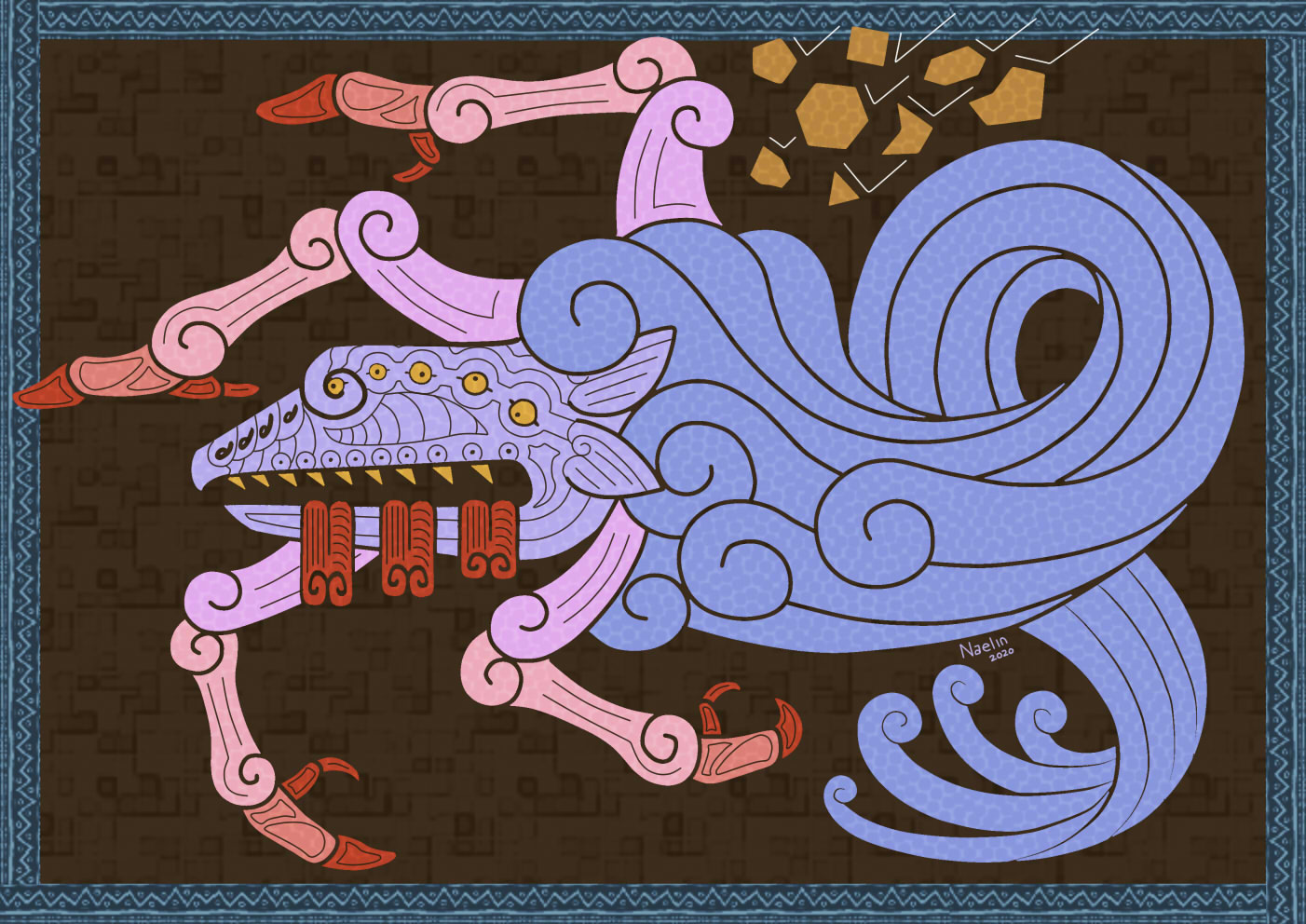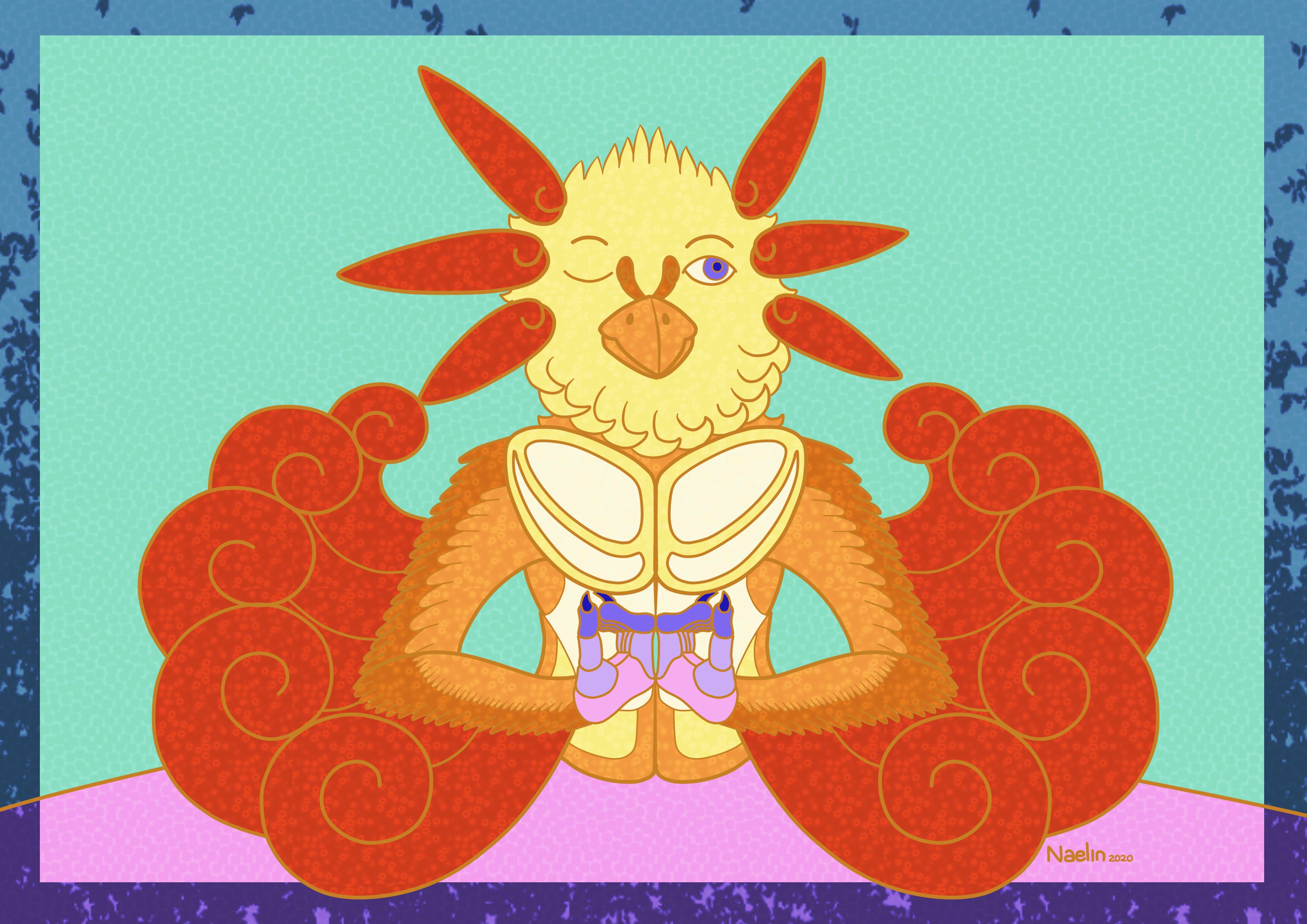Rheshnaghty, the Intention
In the Autonomist religion, practised in the Dhalmain Island, the universe and its inner workings are believed to have been created by the primogenial existence of Curiosity, who gave birth to the first Laws of the Universe as she started wondering about things.
Intention was the tenth and last of the Curious Laws to be created, born after Time, Space, Directions, Dimensions, Physics, Matter, The World and Chemistry.
The Law of Intention is referred to in the Autonomist mythos with the name of Rheshnaghty. They are one of the two most important deities of the religion, alongside Alocardenas, the Curiosity and is sometimes considered Alocardenas' antagonist in their genesis myth.
The head is adorned with multiple sensory organs such as noses, eyes, tongues, ears and electroreceptors, representing the ability to perceive the environment around them.
They are usually painted in light blue, lilac and pink tones.
Alocardenas made the first four other laws come into being, and they in turn raised another four. The nine laws of the universe, all imbued with the ability to wonder, created every inanimate thing by playing with each other, and then Regicielo, the Chemistry, wondered the last question: Would anything every defy them? With all the pieces in place, her question sparked Life, and the life had within it the last Law of the Universe: Intention.
Life's intention, the thunderous Rheshnaghty, descended upon Alocardenas and consumed her all for themselves, and since that moment all laws and elements of the universe were emptied of wonder and laid passive forever.
This way Rheshnaghty was the last Law to be created, and they made animate beings be born, die, and evolve to create new ways of conquering everything.
Devoutees of specific Laws or people that find the afterlife associated with one of them better will try to lead a life that ensures they turn into their preferred deity. Becoming Intention allows one to be the willpower of the living creatures, giving their family, friends and every other creature the strenght necessary to have a fruitful life. Those that want to turn into the force of Intention try have a life marked by their chosen purpose, or in more recent times they might choose to devote their lives to help the community around them prosper.
Contrary to every other Law of the Universe, there isn't a prescribed method of funerary arrangements that gets one closer to Rheshnaghty, as they are the representation of free will. One must choose their own preferred method, which many modern devote followers take to try to find the one that will further their goal of helping their community the most, such as donation to science or the one that would be the easiest on their families based on their current situation.
Around the decade of 2920 E.Alz, the Temple of Rheshnaghty's lead was taken by the priestess Lush Enis, a woman that took an entirely different approach, by teaching to take Rheshnaghty's "gift of intention" with grace and freedom and choose a life where every person's actions were aimed towards improving their community and helping others.
Lush was assassinated in 2965 E.Alz by the Dhalmanite Parliamentary Guard in front of a crowd of her followers and became the first and only person to be executed for the crime contact weaving.
This action only made her worldview and teachings immensely popular, cementing the change of route of the temple. Their main temple is situated in a town in the southwest of the Republic of Dhalmain called Ascar. The town increased in size with the raise in popularity of this deity, attracting both philanthropists as well as, presumably, several aspiring contact weavers.
Helping and serving others is now considered a sacred act, as it is a way to honour one's ability to control their actions in pursuit of betterment.
While it is not admitted out loud, contact weaving is known to be favoured by the followers of Rheshnaghty as one of the most Intention-driven professions. Rheshnaghty is considered the patron of therapists, warriors, healers, fertility matchmakers, contact weavers, bankers, accountants, merchants and thieves, among others.
Depictions
Neutral pronouns and terms are used to refer to Rheshnaghty in religious writings and discourse, in which they are also sometimes referred to as "The Avalanche-god". Intention is depicted in art as a big head with four extremities coming out of its base, followed by an elaborate trail of clouds or dust and a landslide of rocks, that give the impression of a crawling beast destroying everything in their trail.The head is adorned with multiple sensory organs such as noses, eyes, tongues, ears and electroreceptors, representing the ability to perceive the environment around them.
They are usually painted in light blue, lilac and pink tones.
Rheshnaghty in the Autonomist Mythos
Genesis
The Autonomist genesis talks about the start of the universe and the creation of its laws as a series of answers to primaveal questions, with the first thing to exist having been the Law of Curiosity, known as Alocardenas.Alocardenas made the first four other laws come into being, and they in turn raised another four. The nine laws of the universe, all imbued with the ability to wonder, created every inanimate thing by playing with each other, and then Regicielo, the Chemistry, wondered the last question: Would anything every defy them? With all the pieces in place, her question sparked Life, and the life had within it the last Law of the Universe: Intention.
Life's intention, the thunderous Rheshnaghty, descended upon Alocardenas and consumed her all for themselves, and since that moment all laws and elements of the universe were emptied of wonder and laid passive forever.
This way Rheshnaghty was the last Law to be created, and they made animate beings be born, die, and evolve to create new ways of conquering everything.
Afterlife
In the Autonomist religion, when a societarian dies, they will join the Law of the Universe that their life and death most closely represented.Devoutees of specific Laws or people that find the afterlife associated with one of them better will try to lead a life that ensures they turn into their preferred deity. Becoming Intention allows one to be the willpower of the living creatures, giving their family, friends and every other creature the strenght necessary to have a fruitful life. Those that want to turn into the force of Intention try have a life marked by their chosen purpose, or in more recent times they might choose to devote their lives to help the community around them prosper.
Contrary to every other Law of the Universe, there isn't a prescribed method of funerary arrangements that gets one closer to Rheshnaghty, as they are the representation of free will. One must choose their own preferred method, which many modern devote followers take to try to find the one that will further their goal of helping their community the most, such as donation to science or the one that would be the easiest on their families based on their current situation.
The followers of Rheshnaghty
Being the representation of the living creatures' capacity to take action to an end, Rheshnaghty used to be seen as the "Avalanche-god" that swallows everything, egoist and destructive.
The cult to Intention used to be based on the reverence of the inextricable qualities of societarians and other creatures and their capacity to have intentions was seen as a weapon to be treated with solemnity and care.
This action only made her worldview and teachings immensely popular, cementing the change of route of the temple. Their main temple is situated in a town in the southwest of the Republic of Dhalmain called Ascar. The town increased in size with the raise in popularity of this deity, attracting both philanthropists as well as, presumably, several aspiring contact weavers.
Rheshnaghty's Teachings
Followers of Rheshnaghty believe they represent responsibility, drive and goals. Rheshnaghty is said to be the force of will.From individualism to altruism
Through the last century, these representations have been explained as the belief that Intention is a gift they should use to create and improve things since living beings are now the only ones who can wonder and create new things. However in older writings they're said to be honoured by aiming to act only based on one's desires, manipulating the use of Curiosity to further oneself while controlling carefully the consequences of one's actions. Lush's reformation of the Temple changed the general aim of the teachings from a heavily individualistic approach based on restraint and careful decision-making to a community-centered ideology of free will and goal-building.Helping and serving others is now considered a sacred act, as it is a way to honour one's ability to control their actions in pursuit of betterment.
While it is not admitted out loud, contact weaving is known to be favoured by the followers of Rheshnaghty as one of the most Intention-driven professions. Rheshnaghty is considered the patron of therapists, warriors, healers, fertility matchmakers, contact weavers, bankers, accountants, merchants and thieves, among others.

Divine Classification
Law of the Universe
Religions
Church/Cult
Circumstances of Birth
Intention was born with the first living being, answering the question of whether something would ever defy the Laws of the Universe.
Children
Pronouns
They/Them
Related Myths
Warriors
Healers
Fertility Matchmakers
Contact Weavers
Bankers
Accountants
Merchants
Thieves






Every time I see the art for Rheshnaghty it makes me so happy. This is a great article, I like how things changed after the execution of Lush.